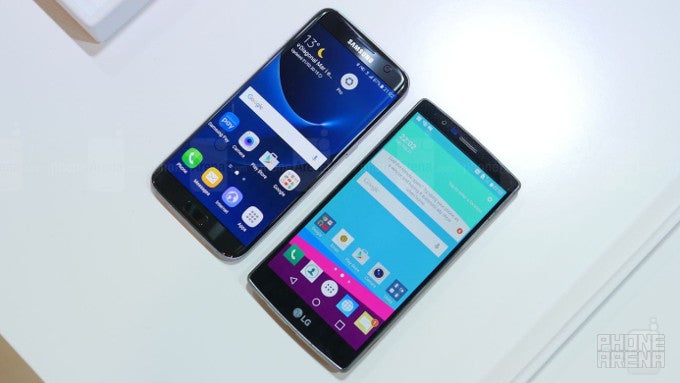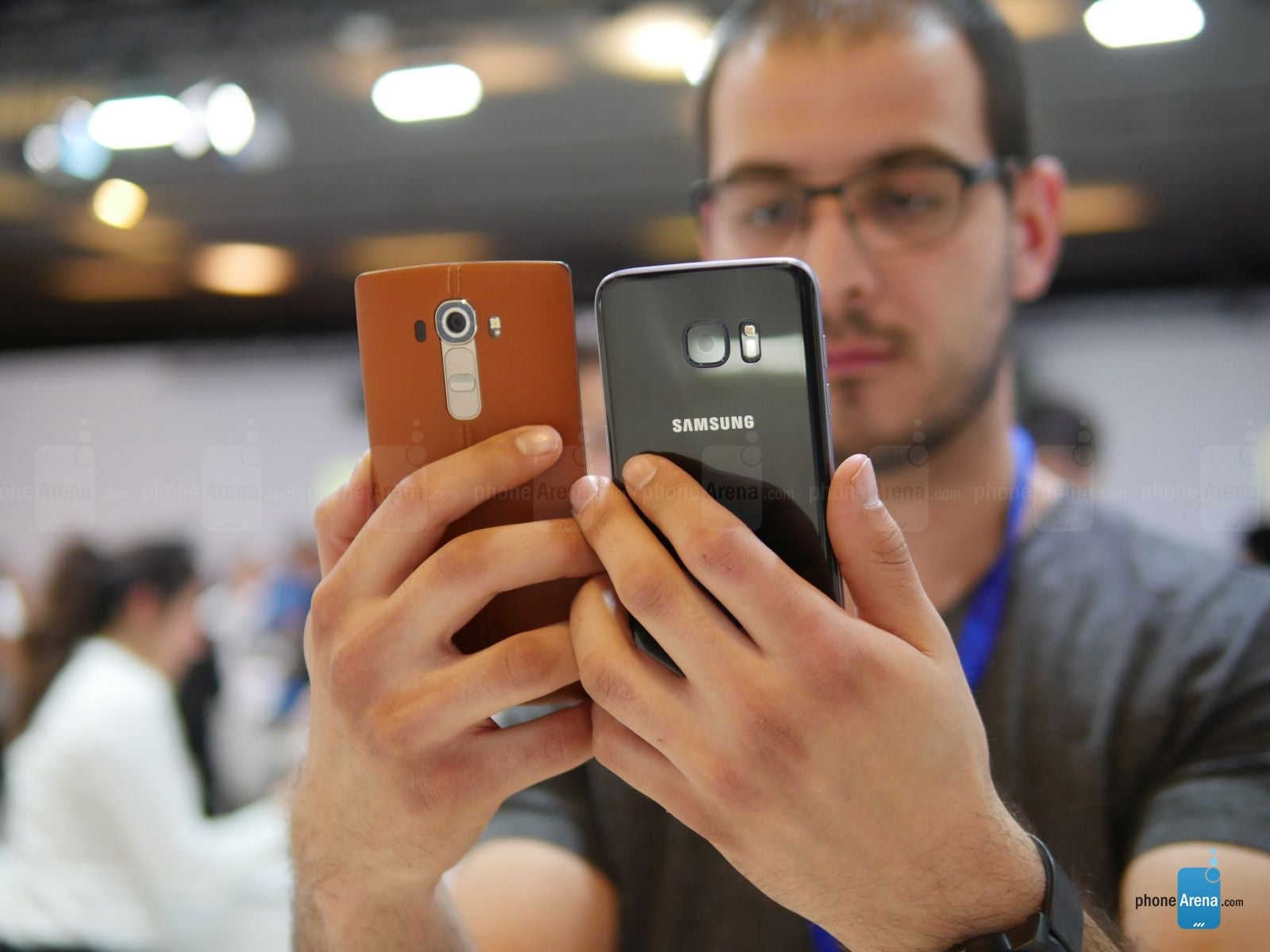Samsung Galaxy S7 edge vs LG G4: first look

Samsung has just announced its Galaxy S7 and Galaxy S7 edge flagship duo and they're just as pretty as the leaks made them out to be. Evolving the shiny looks of the Galaxy S6 line further, the S7s add subtle arches on the back edges for better ergonomics, and a more polished, rounded-off look that softens its rectangular shape further. Additionally, the S7 edge has a very impressive screen-to-body ratio of 76.09%.
Design
Metal and glass has been Samsung's mantra since early 2015, when the manufacturer reimagined how it wants to build its upper range smartphones. The Galaxy S6 edge was a beautiful handset in its own right, but the S7 edge takes the bling even further, with refined shapes that fit better in our hand from the get-go. Its display has been increased to a 5.5-inch diagonal, so we guess the S7 edge is more of a Galaxy S6 edge+ successor, clearly placing the dual-curved smartphone in the phablet range. Its bezels are impressively thin, with a 76.09% screen-to-body ratio making the phone feel manageable in the hand, despite the large display. Its front and back are covered by Gorilla Glass 4 and its body is made out of metal for that extra premium look and feel. Unfortunately, the downside of a glass back is the fact that it attracts a lot of fingerprint grease, so users will have to either put a case on the pretty handset, or wipe it rigorously on a regular basis.
In terms of design, we have to say the Galaxy S7 edge certainly has the more alluring, polished looks. It also offers water-resistance, which is naturally a huge plus. However, we can see how some users might prefer to go for the non-fingerprint magnet, grippier feel of the LG G4 here.
Display
Samsung's Galaxy S7 edge rocks a 5.5-inch, 1440 x 2560 resolution Super AMOLED display. Thanks to the various modes, the screen can be set to either have super-punchy, vivid colors that that AMOLED tech is known for, or a more accurate, subdued color reproduction. Thanks to the versatility and super-crisp resolution, it can easily be called the best display on the market right now.
The G4 has a Quantom IPS 5.5-inch screen, also with a 1440 x 2560 resolution, making it just as sharp as the S7's display. Its colors are punchy and vivid as well, but slightly off. Unfortunately, there's no way to correct that through software settings or presets.
In this categody, we'd say the Galaxy S7 edge wins thanks to its colors, true blacks, and always on feature.
Interface
Samsung's TouchWiz finally looks streamlined and polished. Design elements throughout its various apps and settings fit together in a coherent way, and the interface has been slimmed down to be much less laggy and stuttery than what it was in Galaxy S5 days. Yet it still managed to retain a lot of UX features, such as smart wake / smart call / smart stay, the security manager, et cetera. The interface finally feels like a finished product that runs consistently well throughout.
The edge panels are also making a return — Samsung has expanded them to a wider, 550 pixel area, allowing more information to be fitted on the screen, for actually useful news feeds. Additionally, the tools edge is back, with quick access to a compass, ruler, and flashlight. Sammy will also make the edge panels open for 3rd party developers, which is something we haven't seen since the Note Edge (and some powerusers sorely missed!).
The LG UI on the G4, we feel, is still a bit chaotic and garbled. While LG has less features on it, navigating through the settings or homescreen options could sometimes be a bit confusing to users new to the interface. LG mentioned this very thing when it said that the interface on the G5 is going to be simplified and streamlined.
And this raises another concern. The LG G5 lacks an app drawer and split screen functionality – two features that had to go while the interface was being slimmed down, we suppose. We don't know whether the same simplified interface would be pushed to the G4 with a future Android 6 Marshmallow update or not, so we are slightly concerned about that. We'd think LG wouldn't want to upset G4 users who are used to having the features, but who knows.
The LG UI on the G4, we feel, is still a bit chaotic and garbled. While LG has less features on it, navigating through the settings or homescreen options could sometimes be a bit confusing to users new to the interface. LG mentioned this very thing when it said that the interface on the G5 is going to be simplified and streamlined.
And this raises another concern. The LG G5 lacks an app drawer and split screen functionality – two features that had to go while the interface was being slimmed down, we suppose. We don't know whether the same simplified interface would be pushed to the G4 with a future Android 6 Marshmallow update or not, so we are slightly concerned about that. We'd think LG wouldn't want to upset G4 users who are used to having the features, but who knows.
So, while the Galaxy S7 edge is the multitasker's dream, with the People edge, Apps edge, Tasks edge, and Tools edge, the G5 took a step back for a simplified, one-app-at-a-time experience. Obviously, both smartphones look to cater to two different types of crowds here.
The LG G4 is equipped with a hexa-core Snapdragon 808 and 3 GB of RAM. Despite the fact that LG didn't use the top-of-the-line Qualcomm Snapdragon 810 back when it designed the G4 in 2015, the handset runs pretty smoothly with the occasional stutter. It can definitely sweat and pant when more demanding tasks are involved, however.
The Samsung Galaxy S7 edge has 4 GB of RAM and the brand-new Snapdragon 820 SoC (or Exynos 8890 for select markets) humming under its hood. We ran some quick benchmarks on the Exynos variant of the regular S7, and if they are anything to go by — the Galaxy S7 edge is going to be a true powerhorse. Powerusers that demand nothing but bleeding edge performance from their handset will find it hard not to go with the Galaxy S7edge in this face-off.
In terms of storage, he Galaxy S7 edge is ahead, offering 64 GB of built-in memory. The LG G4 has 32 GB of space. Both smartphones, however, have a microSD card slot for storage expansion.
Processor and Memory
The LG G4 is equipped with a hexa-core Snapdragon 808 and 3 GB of RAM. Despite the fact that LG didn't use the top-of-the-line Qualcomm Snapdragon 810 back when it designed the G4 in 2015, the handset runs pretty smoothly with the occasional stutter. It can definitely sweat and pant when more demanding tasks are involved, however.
The Samsung Galaxy S7 edge has 4 GB of RAM and the brand-new Snapdragon 820 SoC (or Exynos 8890 for select markets) humming under its hood. We ran some quick benchmarks on the Exynos variant of the regular S7, and if they are anything to go by — the Galaxy S7 edge is going to be a true powerhorse. Powerusers that demand nothing but bleeding edge performance from their handset will find it hard not to go with the Galaxy S7edge in this face-off.
In terms of storage, he Galaxy S7 edge is ahead, offering 64 GB of built-in memory. The LG G4 has 32 GB of space. Both smartphones, however, have a microSD card slot for storage expansion.
Camera

On the front, the Galaxy S7 has a 5 MP snapper, while the G4 has an 8 MP one. So, in theory, LG's offering could possibly take more detailed mugshots, but, as mentioned, we've yet to side-by-side them in equal conditions.
Battery
Inside the Galaxy S7 edge, we have a huge 3600 mAh battery. Given the power-efficient hardware thrown into the handset, we’d expect it to last sufficiently long between charges (pre-launch rumors claimed a 2-day battery life), although only in-depth testing will confirm if that’s the case. We are especially curious to see whether the always on display feature drains too much juice.
The LG G4’s battery holds a 3000mAh juicebox, but our benchmarks have shown that the phone’s battery life is only average, probably due to the energy demands of its hardware. Oh well, at least the G4’s cell is removable and can be swapped when needed. As long as you have a spare, of course.
Expectations
All in all, the Samsung Galaxy S7 edge looks like an impressive smartphone, potentially among the top most powerful smartphones for 2016. It is, hands-down, one of the best choices for users that want nothing but bleeding edge tech and performance from their Android handset. Its design catches the eye, its camera looks very promising, and its hardware should be able to handle anything you throw at it.
The LG G4 could be a worthy alternative, especially since we expect its price to drop now that the G5 has been announced. It may not have as much raw processing power, and is less shiny with its plastic build, but the leather back design has its appeal and that 16MP main camera does not disappoint. Besides, the G4 offers you a removable battery, a slightly larger display, albeit with inaccurate colors, and a built-in IR blaster.














Things that are NOT allowed: